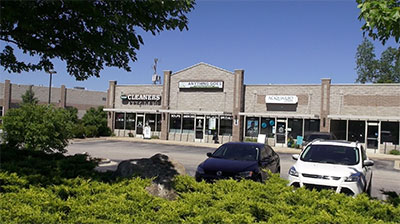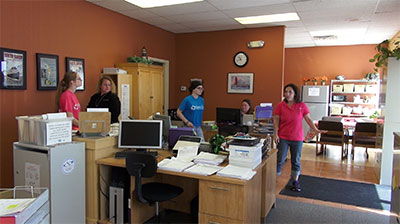Deciding your shot sequence can be done on the fly or with preparation. A retail shop may only need to be shot at one location and time. A roofer may want to capture several customer job sites over several weeks. It may make sense for retailers to present a "virtual visit" to help customers envision shopping at their store. It may make sense to have a customer "tell the story" of their buying experience. Here are our best ideas.
Marketing research: what consumers want in a small business marketing video. If you haven't already, review the survey results.
1. Establishing Shot: The purpose of an establishing shot is to show the viewer where they are. This requires a wide shot/long shot as opposed to medium or close-up. Providing customers with a big-picture, bird's-eye-view of the business from a distance will help them visualize being able to recognize the location when driving to it. (Narration begins in background.)


Open with two four-second shots of the building, one from a distance to help customers identify the building in its surroundings, and one of the building itself. Try to avoid having anything distracting in the foreground of your shot such as a car. Avoid opening with a graphic logo unless it is on top of authentic B-roll footage. Another option is to slow zoom in or out for about 8 seconds. Consider including a shot of the parking lot to help people visualize the ease of doing business with you.

The most common shot length is four seconds. If your business primarily makes service calls, open with the company vehicle arriving at a job site from the perspective of the customer's home. This will help customers visualize doing business with you.
2. Virtual Visit: Show the customer what they would see if they were visiting. If your business sells ambiance or a fun experience such as a restuarant, include close up shots. If your business does not, such as a plumber, avoid using close ups. Wide shots provide information, close ups build a feeling. The shot sequence for a restautant may look something like this, "wide shot, medium shot, close up, close up, medium shot, wide shot." A shot sequence for a plumber may look something like this, "wide shot, wide shot, medium shot, wide shot, medium shot." Make your video about what you can do for the customer. For some business types it can be beneficial to tell your story, if this is you, only tell it to the extent that it communicates what you can do for the customer. Avoid the temptation to make your message self-congratulatory.

Show what the customer would see if they were walking in the door. If it is a large open area, take a slow pan of their initial view. If the view is limited, take a still, or short slow pan of what they would see.

Show the crew setting up and going to work.

Continue to take the viewer on a tour of the business with mostly stills, but including pans, zooms or rolling on a track where it is useful.

Continue showing the crew working on varying tasks.
3. Cut to the Narrator. The narrator has been speaking in the background until now.

In editing, we suggest cutting to the narrator for the first time around the 20 second mark for 1-minute vidoes, or 16 seconds for a 40-second video. B-roll shots of the building, vehicles, equipment and staff take a higher priority than showing the person speaking.
4. Business in Action. Shots that fill the next 20 seconds (for a 1-minute video)

Resume with shots of the business in action, features, samples, or before-and-afters that will often line up with what the narrator is talking about. Try to choose B-roll shots that relieve the most customer pain, or demonstrate the highest level of difficulty. For example, a cleaning service should be shown scouring a bathtub or sanitizing the inside of a refrigerator as opposed to dusting a fireplace mantle.

Businesses that sell ambiance such as restaurants, bars, spas, theaters should incorporate more closeups and camera effects such as slow motion, shorter scenes and blurred transitions using the aperture setting on a DSLR camera. They should be more entertaining and include background music.

5. Return to the Narrator.

We suggest cutting to the narrator for the second time around the 40 second mark if it is a 1-minute video.
6. Business in Action: Shots that fill the next 20 seconds


Continue with your action shots of the business. Repeat these last 2 steps, aiming to keep your video between 1 and 2 minutes.
7. Concluding the Video.


End with a shot of the building while slowly zooming out, and/or group shot of the staff in front of the vehicles, or similar final shot. If you want your logo in the video, place it on top of action shots rather than a solid color or animated screen.
Copyright 2018. Permission to post on your website or print with crediting link to Biveo.com.